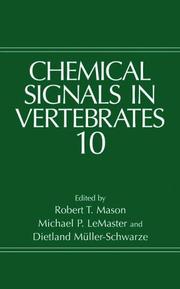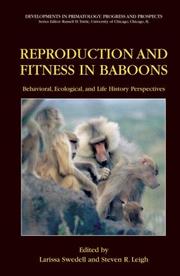| Listing 1 - 10 of 128 | << page >> |
Sort by
|
Periodical
ISSN: 2036265X 20362641 Year: 2009 Publisher: Pavia, Italy PagePress
Abstract | Keywords | Export | Availability | Bookmark
 Loading...
Loading...Choose an application
- Reference Manager
- EndNote
- RefWorks (Direct export to RefWorks)
Evolution (Biology) --- Animal evolution --- Animals --- Biological evolution --- Darwinism --- Evolutionary biology --- Evolutionary science --- Origin of species --- Evolution --- Biology --- Biological fitness --- Homoplasy --- Natural selection --- Phylogeny
Periodical
Abstract | Keywords | Export | Availability | Bookmark
 Loading...
Loading...Choose an application
- Reference Manager
- EndNote
- RefWorks (Direct export to RefWorks)
Evolution (Biology) --- Animal evolution --- Animals --- Biological evolution --- Darwinism --- Evolutionary biology --- Evolutionary science --- Origin of species --- Biology --- Evolution --- Biological fitness --- Homoplasy --- Natural selection --- Phylogeny
Book
ISBN: 9781685711375 Year: 2023 Publisher: Santa Barbara : Punctum Books,
Abstract | Keywords | Export | Availability | Bookmark
 Loading...
Loading...Choose an application
- Reference Manager
- EndNote
- RefWorks (Direct export to RefWorks)
"A hog, a fox, a dog, mud, seawater, an ass, a weasel, a mare, an ape, and a bee. Kim Rosenfield loves (and loves to infiltrate) the language of systems: lists, tables, trees, graphs, catalogs, taxonomies. She’s also interested, at the same time, in the diverse forms of secular enchantment that capitalist modernity generates--both the good or hopeful variety (literary utopias, aesthetic semblance, fairy tales) and the baleful kind, as well (commodity fetishism, feminine mystique, nationalist mythologies). While enchantment is the explicit theme of her previous book Tràma, her interests in both varieties converge in re: evolution."—Introduction.
Evolution (Biology) --- Animal evolution --- Animals --- Biological evolution --- Darwinism --- Evolutionary biology --- Evolutionary science --- Origin of species --- Biology --- Evolution --- Biological fitness --- Homoplasy --- Natural selection --- Phylogeny

ISBN: 0465044255 0465044263 9780465044252 Year: 2001 Publisher: New York : Basic Books,
Abstract | Keywords | Export | Availability | Bookmark
 Loading...
Loading...Choose an application
- Reference Manager
- EndNote
- RefWorks (Direct export to RefWorks)
A pillar of evolutionary biology, Mayr (comparative zoology, Harvard U.) writes for three types of readers: anyone, biologist or not, who wants to know more about evolution; those who accept evolution but doubt the Darwinian explanation of it; and creationists who want to learn more about it even if only to challenge it better.
Evolution. Phylogeny --- Evolution (Biology) --- Evolution (Biologie) --- evolutiebiologie --- evolutietheorie (darwinisme) --- biologie évolutive --- théorie de l'évolution (darwinisme) --- Evolution (Biology). --- Animal evolution --- Animals --- Biological evolution --- Darwinism --- Evolutionary biology --- Evolutionary science --- Origin of species --- Biology --- Evolution --- Biological fitness --- Homoplasy --- Natural selection --- Phylogeny
Book
ISBN: 3319916890 3319916882 Year: 2018 Publisher: Cham Springer Nature
Abstract | Keywords | Export | Availability | Bookmark
 Loading...
Loading...Choose an application
- Reference Manager
- EndNote
- RefWorks (Direct export to RefWorks)
The average person can name more bird species than they think, but do we really know what a bird “species” is? This open access book takes up several fascinating aspects of bird life to elucidate this basic concept in biology. From genetic and physiological basics to the phenomena of bird song and bird migration, it analyzes various interactions of birds – with their environment and other birds. Lastly, it shows imminent threats to birds in the Anthropocene, the era of global human impact. Although it seemed to be easy to define bird species, the advent of modern methods has challenged species definition and led to a multidisciplinary approach to classifying birds. One outstanding new toolbox comes with the more and more reasonably priced acquisition of whole-genome sequences that allow causative analyses of how bird species diversify. Speciation has reached a final stage when daughter species are reproductively isolated, but this stage is not easily detectable from the phenotype we observe. Culturally transmitted traits such as bird song seem to speed up speciation processes, while another behavioral trait, migration, helps birds to find food resources, and also coincides with higher chances of reaching new, inhabitable areas. In general, distribution is a major key to understanding speciation in birds. Examples of ecological speciation can be found in birds, and the constant interaction of birds with their biotic environment also contributes to evolutionary changes. In the Anthropocene, birds are confronted with rapid changes that are highly threatening for some species. Climate change forces birds to move their ranges, but may also disrupt well-established interactions between climate, vegetation, and food sources. This book brings together various disciplines involved in observing bird species come into existence, modify, and vanish. It is a rich resource for bird enthusiasts who want to understand various processes at the cutting edge of current research in more detail. At the same time it offers students the opportunity to see primarily unconnected, but booming big-data approaches such as genomics and biogeography meet in a topic of broad interest. Lastly, the book enables conservationists to better understand the uncertainties surrounding “species” as entities of protection.
Zoology. --- Animal ecology. --- Evolution (Biology). --- Animal Ecology. --- Evolutionary Biology. --- Animal evolution --- Animals --- Biological evolution --- Darwinism --- Evolutionary biology --- Evolutionary science --- Origin of species --- Biology --- Evolution --- Biological fitness --- Homoplasy --- Natural selection --- Phylogeny --- Zoology --- Ecology --- Natural history --- Evolutionary biology. --- Life sciences --- Animal ecology
Book
ISBN: 1760464295 1760464287 Year: 2021 Publisher: Canberra ANU Press
Abstract | Keywords | Export | Availability | Bookmark
 Loading...
Loading...Choose an application
- Reference Manager
- EndNote
- RefWorks (Direct export to RefWorks)
Cooperative Evolution offers a fresh account of evolution consistent with Charles Darwin's own account of a cooperative, inter-connected, buzzing and ever-changing world. Told in accessible language, treating evolutionary change as a cooperative enterprise brings some surprising shifts from the traditional emphasis on the dominance of competition. The book covers many evolutionary changes reconsidered as cooperation. These include the cooperative origins of life, evolution as a spiral rather than a ladder or tree, humans as a part of natural systems rather than the purpose, relationships between natural and social change, and the role of the individual in adaptive radiation onto new ground. The story concludes with a projection of human evolution from the past into the future.
Evolution (Biology) --- Darwin, Charles, --- Animal evolution --- Animals --- Biological evolution --- Darwinism --- Evolutionary biology --- Evolutionary science --- Origin of species --- Biology --- Evolution --- Biological fitness --- Homoplasy --- Natural selection --- Phylogeny --- Darwin, Charles, Robert --- science --- Myth --- Cooperation

ISBN: 1280656794 9786610656790 038725160X 0387251596 1441937765 Year: 2005 Publisher: New York : Springer,
Abstract | Keywords | Export | Availability | Bookmark
 Loading...
Loading...Choose an application
- Reference Manager
- EndNote
- RefWorks (Direct export to RefWorks)
The editors and contributors to this volume should be justifiably proud of their participation in the tenth triennial meeting of the Chemical Signals in Vertebrates International Symposium. This meeting was held 27 years after the initial gathering of participants in Saratoga Springs, New York from June 6* to 9*, 1976. Subsequent meetings have been held every three years in Syracuse, New York; Sarasota, Florida; Laramie, Wyoming; Oxford, England; Philadelphia, Pennsylvania; Tubingen, Germany; Ithaca, New York; and Krakow, Poland. This tenth aimiversary symposium was held from July 29* through August 1*' in Corvallis, Oregon and was hosted by the Zoology Department and Biology Programs of Oregon State University. This book also represents the tenth in a series of books on chemical communication, chemical ecology, olfactory and vomeronasal research in vertebrate species. The species covered in the chapters herein range from fish to mammals including humans. By taxonomic breakdown the mammals are the most represented in number of species and chapter contributions. However, the hosts of the meeting endeavored to have some representative contributions covering all of the major vertebrate taxa. As in past years, the meeting was well-represented with just over 100 participants from 13 different nations. Plenary talks focused on some of the non-mammalian groups that have tended to be less represented in these symposia. Thus, we had a very nice overview of comparisons and contrasts of invertebrate chemical commimication to vertebrate systems.
Chemical senses --- Vertebrates --- Physiology --- Ecology. --- Evolution (Biology). --- Vertebrates. --- Zoology. --- Evolutionary Biology. --- Biology --- Natural history --- Animals --- Vertebrata --- Chordata --- Animal evolution --- Biological evolution --- Darwinism --- Evolutionary biology --- Evolutionary science --- Origin of species --- Evolution --- Biological fitness --- Homoplasy --- Natural selection --- Phylogeny --- Balance of nature --- Bionomics --- Ecological processes --- Ecological science --- Ecological sciences --- Environment --- Environmental biology --- Oecology --- Environmental sciences --- Population biology --- Ecology --- Ecology . --- Evolutionary biology.

ISBN: 0387336745 0387306889 1441940367 Year: 2006 Publisher: New York : Springer,
Abstract | Keywords | Export | Availability | Bookmark
 Loading...
Loading...Choose an application
- Reference Manager
- EndNote
- RefWorks (Direct export to RefWorks)
This volume brings together current research on the behavior, ecology, reproduction, and life history - and the interrelations among these variables - of baboons of the genus Papio. Baboons, found throughout Africa and into Arabia, represent one of the best-known primate lineages, renowned for their ecological and behavioral flexibility and adaptability. These characteristics are intimately intertwined with features of baboon life history and reproduction. Contributors to this volume, representing several major, long-term research projects from throughout the African continent, explore reproductive behavior and strategies of adult male and female baboons in a variety of ways. In Part I, authors explore various aspects of baboon reproduction and social organization, focusing on issues such as infanticide, mating strategies and investment, hybridization and genetics in examining how adults go about mating and reproducing. In Part II, these aspects of life are juxtaposed with detailed examinations of life history and parental investment. Together, the chapters in this volume explore reproduction and parenting from a variety of angles and motivate research from both the parental and offspring perspectives and at a variety of taxonomic levels. Articulating studies of reproduction with those of life history conveys a richly detailed portrait of life phases with critical evolutionary consequences. These lines of inquiry together forge new ways to investigate the life periods that matter most in evolution.
Baboons --- Sexual behavior. --- Reproduction. --- Cercopithecidae --- Evolution (Biology). --- Veterinary medicine. --- Evolutionary Biology. --- Veterinary Medicine/Veterinary Science. --- Farriery --- Large animal medicine --- Large animal veterinary medicine --- Livestock medicine --- Veterinary science --- Medicine --- Animal health --- Animals --- Domestic animals --- Livestock --- Animal evolution --- Biological evolution --- Darwinism --- Evolutionary biology --- Evolutionary science --- Origin of species --- Biology --- Evolution --- Biological fitness --- Homoplasy --- Natural selection --- Phylogeny --- Diseases --- Losses
Book
ISBN: 1280937416 9786610937417 3540692762 3540692754 3642088767 Year: 2007 Publisher: Berlin ; London : Springer,
Abstract | Keywords | Export | Availability | Bookmark
 Loading...
Loading...Choose an application
- Reference Manager
- EndNote
- RefWorks (Direct export to RefWorks)
Across the globe, about 250 species of rodents spend most of their lives in safe and stable, but dark, oxygen-poor and carbon dioxide-rich burrows, deprived of most of the sensory cues available aboveground. They have become fully specialized for a unique way of life in which foraging and breeding take place underground. The systematic research into adaptations of subterranean dwellers is only about two decades old, but it has rapidly intensified within the last few years, bringing insight into many aspects of the biology and evolution at different organization levels. Subterranean Rodents presents achievements from the last years of research on these rodents, divided into five sections: ecophysiology; sensory ecology; life histories, behavioural ecology and demography; environmental and economical impact; molecular ecology and evolution. It is a must for all researchers working in this field and will be of interest to zoologists, physiologists, morphologists, ecologists, and evolutionary biologists.
Rodents. --- Burrowing animals. --- Rodents --- Adaptation. --- Animals --- Animal burrowing --- Rodentia --- Mammals --- Zoology. --- Animal physiology. --- Animal ecology. --- Evolution (Biology). --- Vertebrates. --- Animal Physiology. --- Animal Ecology. --- Evolutionary Biology. --- Animal evolution --- Biological evolution --- Darwinism --- Evolutionary biology --- Evolutionary science --- Origin of species --- Biology --- Evolution --- Biological fitness --- Homoplasy --- Natural selection --- Phylogeny --- Vertebrata --- Chordata --- Zoology --- Ecology --- Animal physiology --- Anatomy --- Natural history --- Physiology --- Evolutionary biology.
Book
ISBN: 1281276006 9786611276003 1402082746 1402082738 9048178282 Year: 2008 Publisher: New York : Springer,
Abstract | Keywords | Export | Availability | Bookmark
 Loading...
Loading...Choose an application
- Reference Manager
- EndNote
- RefWorks (Direct export to RefWorks)
Much of our knowledge of stem cells has been inferred from studies of remarkable few species. The ability to manipulate stem cells in “model” organisms such as the mouse and a few other vertebrate species has driven our understanding of basic biology of stem cells. The power and efficiency of studying model organisms, however, comes at a cost since a few species, obviously, do not reflect nature´s true diversity. Unfortunately, although all multicellular organisms seem to rely on stem cells, and although this seems to be a question of key importance for understanding the evolution of animal life, little is known about stem cells in early-branching taxa. “Stem Cells: From Hydra to Man” illustrates that there is more than human and mouse stem cells to learn from. Reflecting an enormous growth in the knowledge of stem cells in various organisms, the book presents the conceptual language and the nature of questions, as well as a summary of the advances in our understanding of stem cells from a comparative point of view that has resulted from the development of new technology and the development of novel model organisms over the past few decades. As such this book is largely a horizon analysis of a frontier rather than a retrospective. It presents an integrative approach to animal stem cells and covers the major contributions, tools and trends in a newly emerging field: comparative stem cell biology.
Stem cells. --- Physiology, Comparative. --- Comparative physiology --- Medicine, Comparative --- Zoology --- Colony-forming units (Cells) --- Mother cells --- Progenitor cells --- Cells --- Cytology. --- Developmental biology. --- Evolution (Biology). --- Cell Biology. --- Developmental Biology. --- Evolutionary Biology. --- Animal evolution --- Animals --- Biological evolution --- Darwinism --- Evolutionary biology --- Evolutionary science --- Origin of species --- Biology --- Evolution --- Biological fitness --- Homoplasy --- Natural selection --- Phylogeny --- Development (Biology) --- Growth --- Ontogeny --- Cell biology --- Cellular biology --- Cytologists --- Cell biology. --- Evolutionary biology.
| Listing 1 - 10 of 128 | << page >> |
Sort by
|

 Search
Search Feedback
Feedback About UniCat
About UniCat  Help
Help News
News